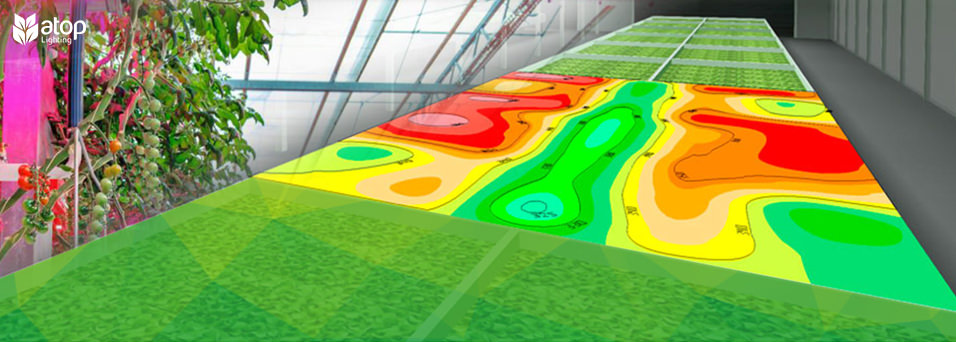A Guide to Greenhouse Light Plan
When it comes to greenhouse cultivation, supplemental lighting is important. Quality, yields, and productions of crops are highly depended on the amount of photosynthetic light they absorb. Artificial lights supplement light for crops during the dark or cloudy days, helping them grow better. However, only appropriate greenhouse lighting can create benefits and perfect results to crops. There are various factors to be considered for a successful greenhouse lighting system. How much light do crops need? What kinds of artificial light should you use? How to layout the fixtures? It is impossible to have a good result if you place too many or too few lighting fixtures on the top of crops. Therefore, you need a well-designed greenhouse light plan. With this light plan, you can maximize the use of artificial lights and get the best growth result with minimum lighting fixtures.

What is greenhouse light plan
In short, a greenhouse light plan provides accurate simulation of the quantity and layout of artificial lights required for your location and business goal. A well-designed greenhouse light plan will figure out the minimum supplemental lighting you need by considering natural light and DLI (Daily Light Integral) as well. It will also help you optimize energy use without compromising the beneficial lighting effects on crops.
How to create a greenhouse light plan
A greenhouse light plan is developed based on specific condition of your greenhouse. To create a good greenhouse light plan, several important considerations should be taken into account. Then, simulating greenhouse light plan helps to optimize your lighting strategies, such as the placement of lighting fixtures and light zones.
Important considerations
So many factors should be considered to create a good greenhouse light plan. These factors include the type of artificial light, lighting requirements, greenhouse location, crop layout, greenhouse footprint, light intensity, uniformity, etc. Here, we list some important considerations for reference.
-
What crop are you going to grow?
Firstly, decide what crop do you want to grow. This is the foundation for a good greenhouse lighting plan. Lighting requirements vary from crop to crop. Even the same crop has different needs of light intensity in different growing stage. After you have decided on the crop you grow, you can clearly understand the needs of the crop. On this basic, you are more likely provide the right spectrum and intensity for your crop.
-
What type of artificial lights will you use?
Fluorescent light, HPS light, and the LED grow light are the three common types of artificial light for greenhouse cultivation. You should consider the spectrum your crops need when selecting the type of lighting fixtures. Compared to Fluorescent lights and HPS lights, the spectrum of LED grow lights is customizable. The customized light spectrum meets the needs of crops precisely, contributing to healthy and thriving growth. Moreover, LED grow lights are more efficient than fluorescent lights and HPS lights. They are able to produce the same light output with less energy consumption. Therefore, we highly recommend that choose LED grow lights for your light plan.
-
How much light do you need?
How much light do your need is the most complicated question in a greenhouse light plan. Since you have decided the crop you plan to grow, you already knew your target DLI (Daily Light Integral, the amount of photosynthetically active photos received in a one-square meter area during 24 hours). The next step is to decide the quantity and location of supplement light to achieve the target DLI as well as uniform lighting distribution.
Supplemental light requirement is related to both external and interior greenhouse light condition. But the measurement of DLI is not only affected by your greenhouse location and seasons, but also the greenhouse structures and shadow. It is not difficult to understand that the outdoor DLI changes as season rolls on. The geography of greenhouse also have impact on outdoor DLI. What about the greenhouse structures and shadow? Greenhouse structures such as the roof material will affect the actual amount of sunlight that arrives the greenhouse interior because of their different light transmittance rates. Objects surrounding the greenhouse such as trees or mountains will case shadows and affect the DLI measurement. The same as supplemental lights. Improper arranged artificial lights will cast shadows that block crops from absorbing light.
Greenhouse lighting simulation
Providing the maximum lighting efficiency for your crops with the minimum cost is difficult. But that is what light plan and simulation are all about. A greenhouse light plan is developed to reach your goals in the most effective and efficient way. The lighting simulation offers a clear picture of the light plan in advance. It shows you how much light each crop can receive under the light plan. Thus, you can check whether the light plan works for your crops. It also allows you to optimize your light plan.
Atop presents a team with total 30 professional optical experts, we investigate how the lamp effects on plants, we are matured on resource integration so to provide more energy-saving, precise and efficient solutions to maximize your growth. Our team would offer the light plan and simulation report telling how many & where to install the luminaires to get the best growth result with minimum luminaires in your project.
Contact us and get your tailored greenhouse light plan and recommendation.


